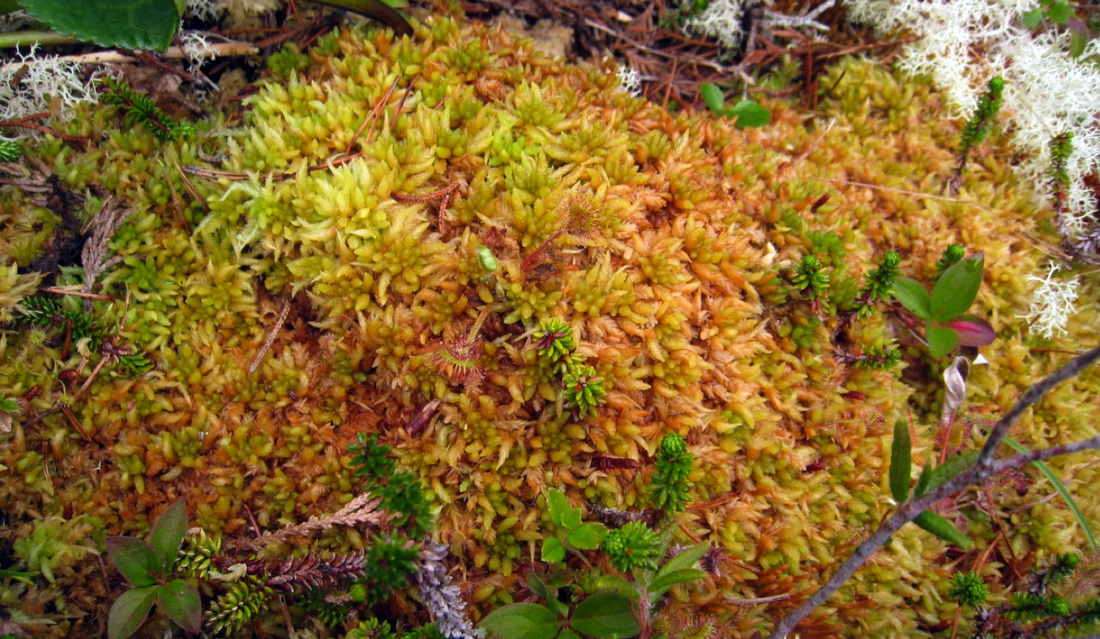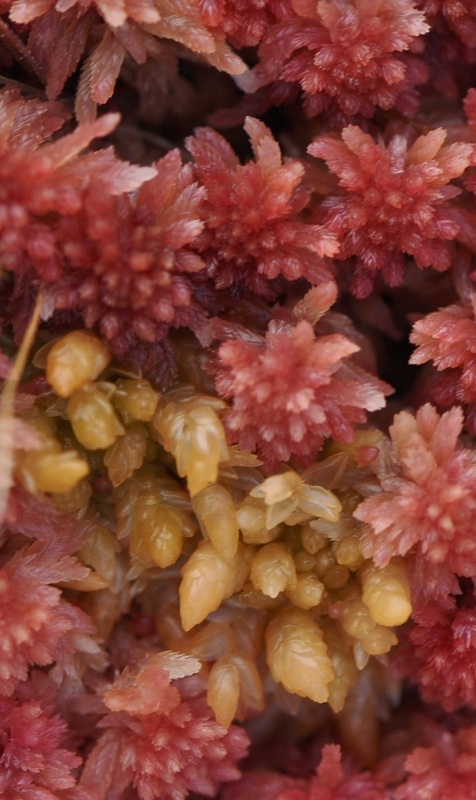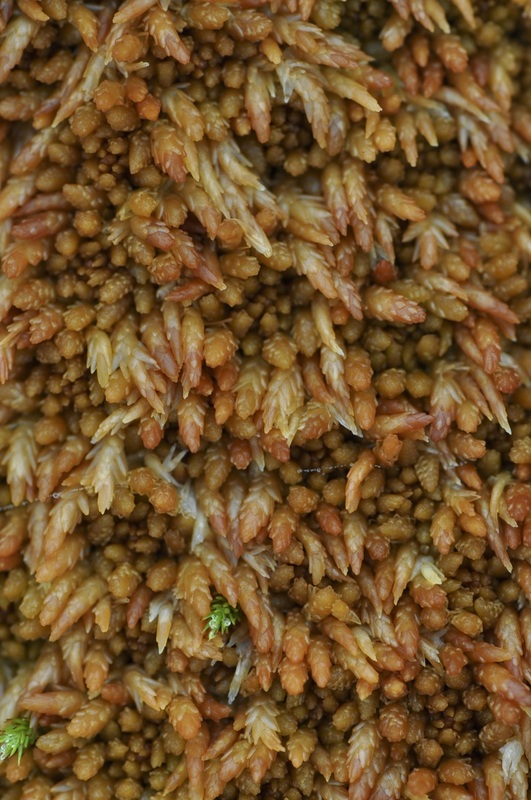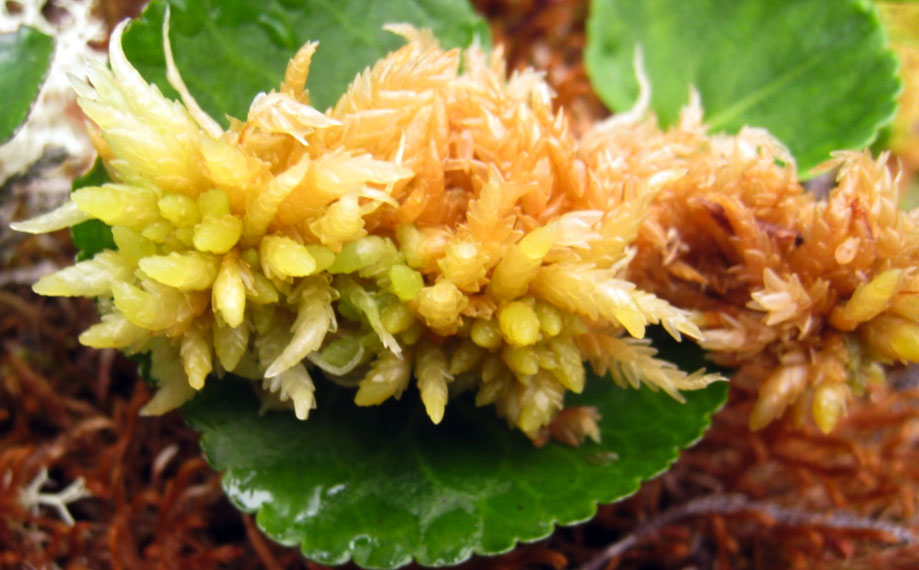Fat bog moss, papillose bog-moss • Sphagnum papillosum
|
Bottom left: small amount of fat bog moss among Sphagnum rubellum. Photos by Amy Harzenberg (top left and bottom right) and Kira Hoffman.
|
Identification
Fat bog moss is usually a pale yellowish-brown, but can vary from greenish to brownish. It is swollen and fat, as per its common name, and robust in appearance. It has short, stubby, blunt-tipped branches and a compact capitulum. The stems are brown. Fat bog moss is a soft peat moss. Click here for further identification information.
Habitat & Range
Fat bog moss forms dense lawns and hummocks in acidic, nutrient-poor fens. It doesn't commonly grow in bogs, though may grow on floating mats in small boggy lakes. Fat bog moss often grows among magellanic bog-moss (Sphagnum magellanicum) and S. rubellum. It grows from sea level to subalpine elevations. Its recorded range in the Pacific Northwest extends from Alaska to northern Oregon; it is also recorded in other regions of North America and in the United Kingdom.
Similar Species
Austin's bog-moss (Sphagnum austinii) has longer tapered branches interspersed between shorter fat ones, and it forms hard hummocks. Magellanic bog-moss is usually all red or red mixed with green; however occasionally all-green forms do occur, and these can be difficult to differentiate from greenish forms of fat bog moss as they occur in the same habitat. See the identification resources linked above for smaller details that can help differentiate fat bog moss in such circumstances.
iNaturalist
https://www.inaturalist.org/taxa/143516-Sphagnum-papillosum
Fat bog moss is usually a pale yellowish-brown, but can vary from greenish to brownish. It is swollen and fat, as per its common name, and robust in appearance. It has short, stubby, blunt-tipped branches and a compact capitulum. The stems are brown. Fat bog moss is a soft peat moss. Click here for further identification information.
Habitat & Range
Fat bog moss forms dense lawns and hummocks in acidic, nutrient-poor fens. It doesn't commonly grow in bogs, though may grow on floating mats in small boggy lakes. Fat bog moss often grows among magellanic bog-moss (Sphagnum magellanicum) and S. rubellum. It grows from sea level to subalpine elevations. Its recorded range in the Pacific Northwest extends from Alaska to northern Oregon; it is also recorded in other regions of North America and in the United Kingdom.
Similar Species
Austin's bog-moss (Sphagnum austinii) has longer tapered branches interspersed between shorter fat ones, and it forms hard hummocks. Magellanic bog-moss is usually all red or red mixed with green; however occasionally all-green forms do occur, and these can be difficult to differentiate from greenish forms of fat bog moss as they occur in the same habitat. See the identification resources linked above for smaller details that can help differentiate fat bog moss in such circumstances.
iNaturalist
https://www.inaturalist.org/taxa/143516-Sphagnum-papillosum
References
Amphlett, A. and Payne, S. Sphagnum magellanicum. British Bryological Society. Accessed 28/08/2014.
Amphlett, A. and Payne, S. Sphagnum papillosum. British Bryological Society. Accessed 28/08/2014.
Ellis, S. Sphagnum papillosum. Introduction to Bryophytes. Biology 321, Department of Biology, University of British Columbia, Vancouver. Accessed 28/08/2014.
Pojar, J. and MacKinnon, A. (1994). Plants of Coastal British Columbia. Vancouver, BC: Lone Pine Publishing. P. 448.
Authors and editors of page
Kelly Fretwell and Brian Starzomski (2014).
Amphlett, A. and Payne, S. Sphagnum magellanicum. British Bryological Society. Accessed 28/08/2014.
Amphlett, A. and Payne, S. Sphagnum papillosum. British Bryological Society. Accessed 28/08/2014.
Ellis, S. Sphagnum papillosum. Introduction to Bryophytes. Biology 321, Department of Biology, University of British Columbia, Vancouver. Accessed 28/08/2014.
Pojar, J. and MacKinnon, A. (1994). Plants of Coastal British Columbia. Vancouver, BC: Lone Pine Publishing. P. 448.
Authors and editors of page
Kelly Fretwell and Brian Starzomski (2014).








